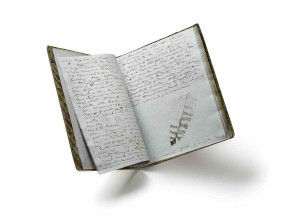The Royal Game of the Goose at the Grolier Club
 The Royal Game of the Goose is one of the earliest printed board games, going back to the Middle Ages—and one of the simplest: just roll the dice and move along its spiral track. This graphically vibrant public exhibition at the Grolier Club brings together over 70 of these games, almost all from the rich international collection of Adrian Seville, game board historian and Emeritus Professor, City University, London. On view from February 24 through May 14, 2016, these beautiful and striking printed games are hardly known in the U.S., and this unique exhibition provides deep insights into the cultural history of Europe, with some fascinating glimpses of America, too.
The Royal Game of the Goose is one of the earliest printed board games, going back to the Middle Ages—and one of the simplest: just roll the dice and move along its spiral track. This graphically vibrant public exhibition at the Grolier Club brings together over 70 of these games, almost all from the rich international collection of Adrian Seville, game board historian and Emeritus Professor, City University, London. On view from February 24 through May 14, 2016, these beautiful and striking printed games are hardly known in the U.S., and this unique exhibition provides deep insights into the cultural history of Europe, with some fascinating glimpses of America, too.
This classic game has been used as a template for thousands of variant games throughout Europe. They range from the earliest educational games of the 17th century to games of advertising, politics and propaganda of the modern era.
Its name originates from the symbol of a lucky goose on the favorable spaces, while the unfavorable spaces, each on their characteristic numbers, symbolize the adversities of human life. The winning space in the classic Goose game is on the “climacteric” number 63, reflecting medieval numerology. And if you hit “death” on space 58 you must begin again!
The images in these games illustrate the themes. So, in a game about the 18th century Navy, the death space at 58 might show a shipwreck, while instead of a favorable goose there could be a favorable wind.
Though the games are simple to play, most are not for young children. Indeed, several princes of Europe are significant in its early history. So, here is a unique early 17th century print of the Game of Cupid, from the fabled rue Montorgueil in Paris, whose numerology represents the union of male and female - and whose track is laid out on a fine crowned serpent to warn against sin! Another French print, the Gifts of Youth, is a party game with forfeits: a young man landing on “inconstancy” must submit to being tied to his chair by his partner’s garter.
Some games celebrate science and invention: here is Benjamin Franklin in Paris witnessing “the first balloon raised in the atmosphere by means of inflammable air”, while a Dutch game of the 19th century showcases Edison, prominently surrounded by his electric light bulbs.
Others are from the early days of advertising. A game in the shape of the newly-built Eiffel Tower promotes luxury French dolls but warns against buying a cheap German import - the broken doll appears on the “death” space, an early example of “knocking” copy.
One section of the exhibition is devoted to Images of America. A meticulously-engraved game of the mid-17th century shows remarkable images of the early Native American peoples. Another celebrates the running of the Southern blockade by British ships during the American Civil War. And a truly incredible novel by Jules Verne provides the basis for the Noble Game of the United States, in which the possible benefactors of a Chicago millionaire’s will battle for the money by competing in a gigantic Goose game ranging across the States of the Nation.
The final case of the exhibition presents some games of human life arranged for play - do you have what it takes to progress from Errand Boy to successful Banker and Valued Citizen?
As befits the Grolier Club, there is a full range of printing techniques from early woodcut, to fine engraving and modern lithography. Some games were issued as broadside sheets, others are folded on linen or on pasteboard. Not all the games follow the classic template exactly but all can trace their existence to the parent Game of the Goose.
CATALOGUE
A fully illustrated color catalogue will accompany the exhibition, designed by Rob Banham (Reading University, England), with an introduction by Past President of the Grolier Club William H. Helfand. The 151-page catalogue will be available in early February from Oak Knoll Books: orders@oakknoll.com; www.oakknoll.com.
PUBLIC EVENTS:
COLLOQUIUM: SOME BEAUTIFUL BOARD GAMES
Tuesday, April 5, 2016, 1:00 PM-5:00 PM, reception to follow.
Complementing the exhibition, the Colloquium showcases the great diversity and appeal of board games through the ages and across the world.
Speakers: Irving Finkel (British Museum); Ann Dunn-Vaturi (Metropolitan Museum of Art); Alex de Voogt (American Museum of Natural History); Adrian Seville (City University, London); Andrea Immel (Cotsen Library, University of Princeton); Margaret K. Hofer (New-York Historical Society).
Registration is $75 per person, $25 for students.
FREE GUIDED TOURS will be arranged throughout the period of the exhibition. For details, please contact the Grolier Club.
VISITING THE GROLIER CLUB
47 East 60th Street
New York, NY 10022
212-838-6690
Hours: Monday - Saturday, 10 am to 5 pm
Admission: Exhibitions are open to the public free of charge
FORTHCOMING EXHIBITIONS
March 24-May 28, 2016, “Brush Up Your Shakespeare”: Miniature Designer Bindings from the Collection of Neale and Margaret Albert"
June 1-July 20, 2016. "Artists & Others: The Imaginative French Book, 2000-2015."
Image: The ROYAL and most PLEASANT GAME of the GOOSE. London: printed for Robt. Sayer at the Golden Buck in Fleet Street [c. 1750, reprint of an original from c. 1725]. Copper engraving, 48 ? 36 cm. Collection of Adrian Seville.















